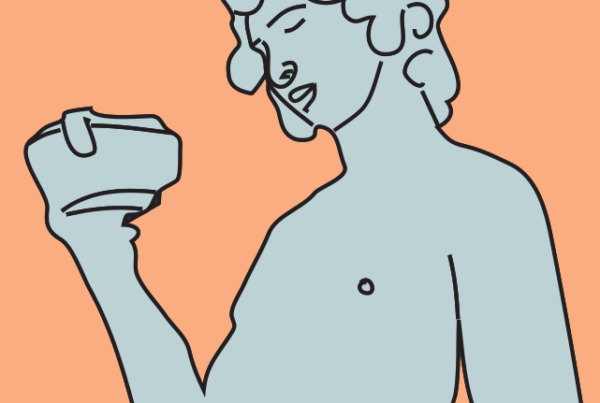
Dear readers,
As the war in Ukraine unfolds, we’re terrified, confused and wonder when it will be over and what happens next. Aside from the existential concerns of people directly and indirectly affected by the war, there is a more general concern about humanity: Are we able to live in harmony? Or is conflict inevitable? Read on as we present you with Spiegeloog 419: Harmony.

Cover by Arianna Cavalli
Our editorial board came up with many pieces related to this topic, ranging from domestic harmony to harmony within oneself. We also want to introduce our new editors that contributed to this issue and welcome them to our growing editorial family: Samarth, Sara, Anika, Vadim, Aniya, Christine and Berenike!
Samarth starts with discussing how social norms influence harmony within society. Ella takes a different turn and outlines the new brain scanning technique, hyperscanning, which is used in researching how brain activity of multiple people is related, or ‘harmonised’. Magda and Emma co-author an article in which they explain why group work at school is so often painful, and they guide us in how to make group work a successful and enjoyable experience. Vadim reflects on his visit to a museum in Paris, as he writes about the ugly face of love in its disruptiveness, and Christine takes her own spin on the topic of harmony, writing about what domestic harmony is and how it is embedded in our everyday life. Sara considers harmony as the synchronisation of the mind with the body. Taking this topic into more abstract realms, Anika talks about how Buddhism and science might complement and not negate each other, when it comes to the idealism-materialism debate. Imran, our guest author, then discusses how social media such as Snapchat invade our freedom by introducing gamification features, and Aniya talks about how building mental palaces can help our memory. Finally, Nitya reviews psychological literature to find out why we like listening to sad music.
This issue’s columns are not less interesting than the articles. We start with a poem written by Berenike, and continue with harmony-related PSYCHsources on music psychology by Rosa. Anne’s Athena column is about whether we should believe in the catharsis hypothesis, and Anushka reviews the book Atlas of the Heart in Tabula Rasa. Magda then writes about the adolescent-themed movie Turning Red, and Laura interviews Ukrainian and Russian students about how their life has changed since the war started. This issue also features our Let’s Mingle! podcast episode, in which Berenike, Anushka and Arda interview a few researchers from the UvA about issues related to conflict and harmony. Finally, Anne in her Bacchus considers how not being in harmony with oneself can be a meaningful experience.
Sit back, relax, and enjoy the new issue!
Milena & Mualla
Dear readers,
As the war in Ukraine unfolds, we’re terrified, confused and wonder when it will be over and what happens next. Aside from the existential concerns of people directly and indirectly affected by the war, there is a more general concern about humanity: Are we able to live in harmony? Or is conflict inevitable? Read on as we present you with Spiegeloog 419: Harmony.

Cover by Arianna Cavalli
Our editorial board came up with many pieces related to this topic, ranging from domestic harmony to harmony within oneself. We also want to introduce our new editors that contributed to this issue and welcome them to our growing editorial family: Samarth, Sara, Anika, Vadim, Aniya, Christine and Berenike!
Samarth starts with discussing how social norms influence harmony within society. Ella takes a different turn and outlines the new brain scanning technique, hyperscanning, which is used in researching how brain activity of multiple people is related, or ‘harmonised’. Magda and Emma co-author an article in which they explain why group work at school is so often painful, and they guide us in how to make group work a successful and enjoyable experience. Vadim reflects on his visit to a museum in Paris, as he writes about the ugly face of love in its disruptiveness, and Christine takes her own spin on the topic of harmony, writing about what domestic harmony is and how it is embedded in our everyday life. Sara considers harmony as the synchronisation of the mind with the body. Taking this topic into more abstract realms, Anika talks about how Buddhism and science might complement and not negate each other, when it comes to the idealism-materialism debate. Imran, our guest author, then discusses how social media such as Snapchat invade our freedom by introducing gamification features, and Aniya talks about how building mental palaces can help our memory. Finally, Nitya reviews psychological literature to find out why we like listening to sad music.
This issue’s columns are not less interesting than the articles. We start with a poem written by Berenike, and continue with harmony-related PSYCHsources on music psychology by Rosa. Anne’s Athena column is about whether we should believe in the catharsis hypothesis, and Anushka reviews the book Atlas of the Heart in Tabula Rasa. Magda then writes about the adolescent-themed movie Turning Red, and Laura interviews Ukrainian and Russian students about how their life has changed since the war started. This issue also features our Let’s Mingle! podcast episode, in which Berenike, Anushka and Arda interview a few researchers from the UvA about issues related to conflict and harmony. Finally, Anne in her Bacchus considers how not being in harmony with oneself can be a meaningful experience.
Sit back, relax, and enjoy the new issue!
Milena & Mualla



